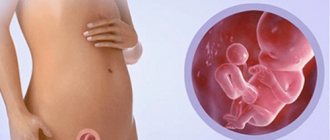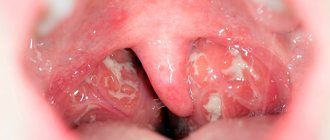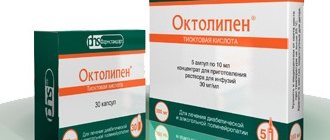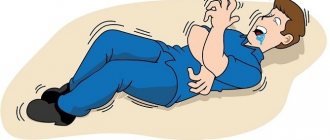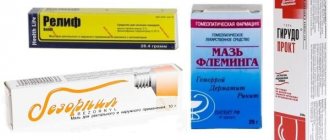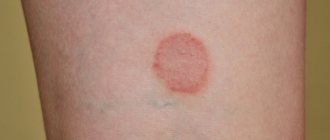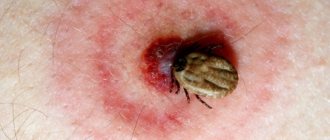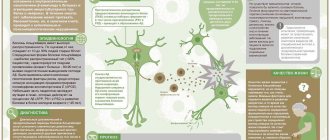Viral meningitis is an inflammatory process that occurs in the membranes of the brain - soft and arachnoid, affecting the subarachnoid space. Viral meningitis is contagious and has dangerous consequences, primarily an asthenic state, which is accompanied by weakness, increased fatigue, poor health, depression, and psycho-emotional disorders.
Similar manifestations can be observed within 3-12 months after treatment. In 30% of patients, neurological disorders persistently persist - deterioration of intellectual activity, paresis and paralysis, convulsive syndrome, hydrocephalus, auditory dysfunction of neurosensory etiology, visual impairment. In 25% of cases, adults develop ischemic stroke. Prevalence is about 5 cases per 100 thousand population annually.
What is meningitis
Meningitis is a disease involving inflammation of the lining of the spinal cord and brain. The main symptoms include migraine, fever, confusion, sensitivity to light and sound, and numbness in the neck.
The main provocateurs are viruses, infections and fungi. Often the disease becomes a complication of an infectious disease. The basis of therapy is the use of antibacterial, antiviral or antifungal agents in a hospital setting.
Most often, the disease affects men and children. The incidence rate increases during autumn and winter. The leading factors of infection are hypothermia, temperature fluctuations, and vitamin deficiency. Scientists also note the cyclical nature of the disease. According to their observations, outbreaks become active once every 10-15 years.
Overview of the Central Nervous System (CNS)
In vertebrates, the most important part of the entire nervous system is the central nervous system (CNS).
The CNS consists of two main components: the brain and the spinal cord.
Both the brain and spinal cord are contained in a protective fluid (cerebrospinal fluid or cerebrospinal fluid), surrounded by various protective membranes (the so-called meninges), and are additionally protected by very hard bone tissue (the skull, the brain and the spinal cord).
Thanks to a huge network of neurons (i.e. nerve cells), the central nervous system is responsible for analyzing information from the internal or external environment of the body and processing the most appropriate responses (to said information).
Types of meningitis in adults
Meningitis, symptoms in adults (how to recognize, you can consult with your doctor) which indicate its severity, is classified according to many criteria - etiology, speed of progression, nature of symptoms and cause of infection.
According to etiology, meningitis is divided into the following categories:
- Primary. It is provoked by infections that penetrate the lining of the brain.
- Secondary. Acts as a complication after an illness caused by an infection.
The disease is also classified according to the speed of development:
- Reactive form. It is characterized by rapid development. Infections such as pneumococcus, streptococcus, and meningococcus act as provocateurs. The disease can also develop as a complication after otitis media, sinusitis, pneumonia and other pathologies. Usually ends in death within 24 hours.
- Acute form. It is provoked by a purulent infection. The disease is characterized by a rapid increase in body temperature. If you do not seek medical help in a timely manner, the pathology can lead to death.
- Subacute form. She has a sluggish character. Symptoms increase slowly over the course of a month.
- Chronic form. It occurs latently in a benign form. The duration of the pathology ranges from a month to 25 years, after which the symptoms suddenly cease to appear.
Due to development, the following varieties are distinguished:
- Tuberculous. It is provoked by the tuberculosis bacillus. In the vast majority of cases, the pathology takes a subacute or chronic form. This type of meningitis is not contagious.
- Viral. The herpes or mumps virus acts as a provocateur.
- Bacterial. It is provoked by staphylococci, E. coli, meningococci and other pathogenic flora.
Based on the nature of the disease, it is divided into the following categories:
- Purulent. This is a serious pathology. The causative agents are meningococcal bacteria. The accumulation of pus causes a sharp deterioration in a person’s general condition and the rapid spread of infection through the blood.
- Meningococcal. The infection penetrates the tissues of the basal and convex regions of the brain. The membrane of the brain swells, which provokes disruption of the functionality of internal organs. This condition can lead to the death of the patient.
- Serous. With inflammation in the spinal cord and brain, there is an increase in the level of lymphocytes.
- Fungal. Fungi such as candida and mycoses are provocateurs.
- Mixed. The trigger mechanism in this case is the parallel impact of bacteria and viruses.
Causes of meningitis
Typically, meningitis is the result of a viral, bacterial or fungal infection.
However, sometimes meningitis can be caused by irritants, such as the use of specific medications, certain physical injuries, brain tumors and systemic diseases.
infectious meningitis is of particular interest , since it is the one that epidemiologically affects the largest number of people.
Viral meningitis
Meningitis of viral origin is the most common form of the disease and usually has less serious consequences.
Today, the viruses that cause viral meningitis are enteroviruses and herpes viruses.
- Enterovirus . They are a group of viruses that cause mild intestinal infections and can be spread by coughing, sneezing and contact (direct or indirect) with contaminated surfaces. Epidemiological studies have shown that enteroviruses are the viruses that cause the majority of viral meningitis.
- Herpes virus . They are a very diverse category of viruses, and they have one thing in common: they no longer leave the infected host and hide in some of its cells (latent infection) to protect themselves from the immune response. Among the herpes viruses, one of the most associated with meningitis is the so-called herpes simplex virus , known for its ability to cause seizures in the corners of the mouth and genital herpes.
Important information : Before the advent of mass vaccination, the main causes of the viral form of the disease were measles , rubella and mumps viruses. Since then, the number of cases of meningitis associated with measles, rubella or mumps has fallen sharply.
Bacterial meningitis
Meningitis of bacterial origin is a rare, but especially dangerous form of the disease, as it can have irreversible consequences or lead to the death of the patient.
Stages and degrees of meningitis in adults
The disease is characterized by stages. In the infectious form, there are three main phases.
| Stage | Symptoms |
| First stage | Increased intracranial pressure, confusion, decreased reflexes, tachyarrhythmia, apnea, convulsions. |
| Second stage | Lack of response to pain, areflexia, bradycardia or tachyarrhythmia. |
| Third stage | Loss of consciousness. |
Unlike meningitis of a bacterial nature, the viral variety is accompanied by serous inflammation.
| Stage | Symptoms |
| First stage | Formation of serous effusion, thickening of the membranes of the brain. |
| Second stage | Swelling in the meninges. |
| Third stage | Impaired outflow of cerebrospinal fluid, increased intracranial pressure, migraine, coma. |
Meningitis, the symptoms in adults (how to recognize it yourself, the therapist will tell you) of which differ in stages, fungal infection with meningitis occurs against the background of immunodeficiency. Often, people infected with HIV suffer from this type of disease. Fungal meningitis is characterized by a serous process of inflammation.
| Stage | Symptoms |
| First stage | Thickening of the tissues of the meninges. |
| Second stage | Petechial effusion of blood. |
| Third stage | Inflammation of the cerebral substance, development of encephalitis, spread of inflammation to the membranes of the spinal cord. |
Signs of the disease in the tuberculosis form are constantly increasing. The incubation period lasts up to 6 weeks.
| Stage | Symptoms |
| First stage | Apathy, excitability, insomnia, loss of appetite. |
| Second stage | Migraine, fever, muscle stiffness. |
| Third stage | Vomiting, coma. |
Often the tuberculosis form leads to death. It is caused by paralysis of the respiratory centers.
Symptoms of viral meningitis
Primary signs of viral meningitis in adults and children include headache, myalgia (muscle soreness), and gastrointestinal disorders. Initial signs may resemble the course of an acute respiratory infection (ARI) with cough, runny nose, and general malaise.
In childhood, heart damage (viral myocarditis) is possible; in infants, swelling of the fontanel is observed. Characteristic meningeal symptoms (Kernig's, Babinski's, Brudzinski's symptoms) may be mild or absent in elderly patients. The type of pathogen affects the dynamics of the course and severity of manifestations. Symptoms characteristic of viral meningitis diagnosed in adults:
- Rigidity (hardness, inflexibility) of the muscles of the neck and back of the head.
- Intense, pulsating, bursting pain in the head area.
- Increased body temperature (usually above 39°C).
- Bradycardia (decreased heart rate, slow pulse).
- Respiratory failure.
- Increased sensitivity to bright light and loud noise.
- Attacks of nausea, often accompanied by vomiting.
The entry of the virus into the area of the meninges leads to an inflammatory process and tissue swelling, and a deterioration in the outflow of cerebrospinal fluid. As a result, intracranial pressure levels increase. In cases where the causative agent is an enterovirus, abdominal pain and diarrhea are observed. If treatment for viral meningitis is not carried out or incorrect therapy is prescribed, neurological symptoms worsen, up to the occurrence of severe, terminal conditions - confusion, coma.
Symptoms of meningitis in adults
Typically, as the disease develops, the following symptoms of pathology appear:
- asthenia;
- myalgia;
- noise in ears;
- increased body temperature;
- intense migraine;
- photophobia;
- skin rashes;
- gastrointestinal function disorder;
- disturbance of consciousness;
- constant vomiting;
- strabismus;
- seizures;
- muscle stiffness;
- nervous excitement;
- dizziness;
- chills.
Meningitis, the symptoms in adults (how to recognize, the above signs will help) of which differ from different origins, the infectious form is characterized by a sudden onset with an acute increase in symptoms.
Often the disease is disguised as a common cold, so diagnosis in the early stages can be erroneous. The symptoms of meningitis depend on the specific bacterium, virus or fungus that acts as the causative agent.
Epidemiology
- Bacterial meningitis mainly affects people under 5 years of age (especially children under one year of age); however, there are cases of infection in people aged 15 to 19 years. According to an epidemiological study conducted in 2011-2012 in the United Kingdom (UK), the number of cases of bacterial meningitis was about 2,350. Meningococcus, which causes most infections, is subtype B. In terms of transmission, experts have found that pneumococcus is spread by coughing and sneezes much more easily than meningococcal infection.
- Like bacterial, viral meningitis also primarily affects children. Autumn and spring are times of year when the risk of contracting viruses is higher.
- The fungal form of the disease is especially common among adults living in Africa.
Causes of meningitis in adults
The serous or viral type is provoked by microorganisms of viral etiology. The most common form is enteroviral meningitis. It develops upon penetration into the gastrointestinal tract. It is highly contagious. The risk group includes older people, as well as people with weakened immune systems.
With the development of bacterial meningitis, it is customary to talk about the penetration of meningococcal infection into the body. This type of pathology is known in medicine as purulent. It has a high level of infectiousness.
The infectious form is provoked by nonspecific bacteria. Most often it is provoked by untimely treatment of bacterial and respiratory diseases. Sometimes it acts as a complication of pneumonia. It is a relatively non-contagious form.
Tuberculous meningitis could be considered a complication of primary tuberculosis infection, but the pathology differs in a number of features. In some cases it acts as the primary species.
Mycobacterium tuberculosis has the ability to infect all tissues and organs. The risk group includes cancer patients, HIV-infected people, and patients suffering from vitamin deficiency.
In the fungal form of pathology, pathogenic and conditionally pathogenic fungi act as pathogens. Infection occurs through airborne droplets, as well as through household contact. Among the pathogens of the fungal form, cryptococci, candida, and coccidia should be noted.
Features of the disease
Viral meningitis is a disease that is considered less dangerous for humans than the bacterial form, which suggests a favorable prognosis. The causative agents of the pathology are often RNA-containing viruses from the Picornaviridae family, known as enteroviruses, mainly ECHO and Coxsackie. 6 pathogenic serotypes of the Coxsackie virus and about 23 pathogenic serotypes of the ECHO virus have been identified, which are resistant to low temperatures, ethyl alcohol (70%), and Lysol (5%).
Microorganisms in the natural environment remain active for several days, exposing people in contact with the outbreak to the threat of infection. The virus dies under the influence of chlorine-containing agents, ultraviolet irradiation, and high temperatures. Meningitis, which is caused by a virus, is a viral disease of the so-called aseptic form.
The pathology develops as a result of damage to the meninges by viruses of mumps, herpes, tick-borne encephalitis, lymphocytic choriomeningitis, cytomegalovirus, adenovirus and others. Transmission of a viral infection often occurs from a sick person, less often from animals and birds. The virus that causes meningitis, depending on the class and serotype of the pathogen, enters the human body through airborne droplets, through direct contact with a patient, through a tick bite, or through entry into the digestive tract.
The incubation period varies and depends on the serotype of the virus - 2-21 days. Viral meningitis is characterized by high contagiousness - the ability to be transmitted to other people. Despite the fact that viral meningitis is transmitted as an infection through respiratory or household contact, there are forms that arise as a result of reactivation of a latent disease, for example, caused by type 2 herpes.
The viral form of meningitis can proceed like the first period of the bacterial one, if the viral infection is complicated by the addition of bacterial pathogenic microflora. This development is typical for patients suffering from chronic inflammatory diseases of the otolaryngological sphere - otitis, pharyngitis, tonsillitis, sinusitis, sinusitis.
The prognosis for viral meningitis, which occurs without complicating factors, is favorable. Usually the disease is mild, recovery occurs within 7-10 days, regression occurs without lasting consequences. The lethal outcome in the absence of complications (usually encephalitis) is about 1%.
Diagnosis of meningitis in adults
Meningitis, symptoms in adults (how to recognize - diagnosis will help) which are determined when the development of pathology is suspected, is detected by instrumental and laboratory tests.
Among them it should be noted:
- Lumbar puncture. Through this method, healthcare professionals obtain samples of cerebrospinal fluid. The procedure involves a puncture in the lower back. Performed under local anesthesia.
- Blood analysis. Blood is taken from a finger or vein. In some cases, blood is cultured for sterility.
- Analysis of urine. Detects infection in the urinary tract.
- Biopsy. Used to differentiate the diagnosis of rash from other skin rashes. A specialist removes the skin layer for subsequent histological study.
- CT and MRI can diagnose complications of the disease that affect the brain.
- X-ray. It is carried out to identify foci of infection in the lungs or paranasal sinuses.
The most productive diagnostic method is a blood test.
Blood cultures make it possible to detect the presence of pneumococci and meningococci. The pattern is an increase in the level of leukocytes. The method is one of the most informative, as it allows one to determine the nature of the occurrence of pathogenic microorganisms.
The collection of cerebrospinal fluid has a high degree of reliability. By studying changes in the cerebrospinal fluid, doctors identify purulent and serous types of pathology and identify the pathogen.
The totality of indicators obtained in the laboratory serves as a direct basis for making a correct diagnosis. CT, MRI and radiography act as additional diagnostic links.
The average price for a blood test in Russia is 890 rubles. In Moscow, a similar service is offered by the Center for Molecular Diagnostics. The cost of a skin biopsy is 745 rubles. CSF analysis costs 1,190 rubles.
Diagnostics
The diagnosis is made on the basis of anamnesis and personal examination by a neurologist, during which the patient’s neurological status is revealed. Blood is taken for general and biochemical analysis to detect traces of inflammation, determine the degree of damage to internal organs, and identify contraindications for lumbar puncture.
An analysis is carried out for the presence of IgM antibodies. In order to confirm suspicions, in the absence of contraindications, a lumbar puncture is performed, followed by a study of the cerebrospinal fluid. Analysis of cerebrospinal fluid shows the presence of the pathogen and the serotype of the virus that caused the inflammatory process.
An electrocardiogram is prescribed if there are signs of heart damage. Using electromyography, bioelectrical activity in skeletal muscles is determined. MRI and CT scans of the brain are indicated for long-term persistence of severe neurological symptoms to identify complications of the disease and the causes of disorders.
When to see a doctor
Only a specialist can recognize the disease if meningitis is suspected. Since the etiology of the pathology is infection, treatment is carried out in an infectious diseases hospital.
Headache is a symptom accompanied by meningitis in adults
Diagnostic measures and therapy should be started as early as possible, since the pathology is fraught with dangerous complications. At the first symptoms in adults, you should call an ambulance and hospitalize the sick person in the hospital.
Seek medical help if you have the following symptoms:
- temperature increase;
- migraine;
- frequent vomiting;
- asthenia;
- loss of consciousness.
As the disease progresses, the person's general condition worsens. He develops delirium, paresis, convulsions, and muscle paralysis.
Etiology
The disease is classified as neurotropic, since the causative agent is meningococcal infection (meningitidis).
Neutropic viruses are capable of infecting neurons (nerve cells), quickly spreading through the bloodstream throughout the body. The danger of such infection is that such viruses are resistant to the immune system. This is why viral meningitis is quite difficult to treat. It is important to promptly identify the pathology based on its characteristic symptoms and carry out the necessary treatment. The disease has dangerous and serious consequences. Diagnosis is only possible in a clinical setting. Due to the fact that the symptoms are reminiscent of the flu, ARVI, the pathology is often detected at a later date. But among all known meningitis, the viral disease has a more favorable course.
Prevention of meningitis in adults
For the purpose of prevention, it is advised:
- Maintain personal hygiene. You should thoroughly wash your hands, vegetables, fruits, dishes, and ventilate living areas.
- Eat a balanced diet.
- Temper the body.
- Take vitamin complexes.
- Make sure there are no ticks on the skin.
- During an acute respiratory infection epidemic, take antiviral drugs.
If there are cases of meningitis infection in organized groups, an emergency notification should be submitted to the Sanitary Epidemiological Service. This measure will make it possible to effectively control the epidemic.
Quarantine involves:
- Timely identification and isolation of a sick person.
- Examination of persons who have been in contact with an infected person.
- Conducting bacteriological research in teams
- Declaration of quarantine in those institutions in which cases of illness have been observed for at least 10 days from the outbreak of the epidemic.
- Carrying out routine and general disinfection of premises and utensils.
- Treatment of premises using ultraviolet lamps.
- Compliance with wearing masks.
- Prohibition of visiting crowded places.
The epidemic also requires drug prevention. If contact with a person infected with meningitis or a bite of an encephalitis tick is recorded, then medications are prescribed.
Usually shown:
- Immunomodulators. Relevant for children under 3 years of age. In this case, the drug is administered intramuscularly once, followed by switching to Interferon. The course of injections is 7 days.
- Antibiotics. They are taken in parallel with antiviral drugs. An effective combination in this case is Doxycycline and Yodantipyrine.
The dosage, duration of therapy and necessary diagnostic measures are prescribed by a specialist.
Vaccination is also carried out to prevent the disease. Most infections that cause meningitis are included in the list of routine vaccinations.
There are some categories of citizens for whom vaccination is a necessary preventive measure:
- children aged from 2 months to 8 years;
- workers of medical institutions;
- employees of educational institutions;
- food industry workers;
- sellers;
- students of schools and universities.
Prevention
There are vaccines that can protect against some diseases such as measles, mumps, chickenpox and influenza that lead to viral meningitis. Ensure that you and your child are up to date with vaccinations.
There are no vaccines to protect against non-polio enteroviruses, which are the most common cause of viral meningitis. The best way to protect yourself and others from non-polio enterovirus infections is to:
- Wash your hands frequently with soap and water for at least 20 seconds, especially after changing diapers or using the toilet.
- Avoid close contact, such as touching and shaking hands, with people who are sick.
- Clean and disinfect frequently touched surfaces.
- Stay home when sick and keep sick children out of school.
- Avoid being bitten by mosquitoes and other disease-carrying insects.
Treatment methods for meningitis in adults
An integrated approach to the treatment of pathology involves the use of etiotropic therapy. Drugs that help destroy the infection are injected into a vein. There are also measures aimed at detoxifying the body and combating cerebral edema.
Medications
In the treatment of purulent meningitis, Ceftriaxone, Gentamicin, and Ampicillin are used. As a rule, two drugs are combined.
When Gentamicin is administered intravenously, the single dose is 1-1.7 mg/kg, the daily dose is 3-5 mg/kg. The medication is administered 2-4 times a day. The duration of treatment is 7-10 days. The cost of 10 ampoules of the drug ranges from 30 to 50 rubles. depending on the manufacturer's brand.
Therapy for viral meningitis involves the use of Acyclovir, Immunoglobulin, Zidovudine.
Immunoglobulin is indicated for adult patients in a dose of 25-50 ml. The drug is not diluted. The rate of intravenous administration is 30-40 drops per minute. The dose of the drug is determined by a specialist. Usually 3-10 infusions per day are prescribed. The cost of the drug ranges from 899 to 13,500 rubles. depending on the dose.
Treatment of meningitis of tuberculous origin is carried out with Kanamycin, Rifampicin, Pyrazinamide. Kanamycin is administered intravenously at a dose of 15 mg/kg/day. (30 min). The maximum daily dose is 1 mg. The duration of treatment is 7 days. The cost of one ampoule is 10 rubles.
Folk remedies
Treatment of meningitis with folk remedies is only possible in this case. If they act as an addition to the main drug treatment. In any case, you should consult a specialist.
To treat viral meningitis, take a linden-based decoction. It has an anti-inflammatory and analgesic effect. In addition, it helps improve immunity.
To prepare the decoction, take 1/4 cup of linden blossom. He is filled with boiling water. The mixture is infused for 10-15 minutes. Drink 1/2 cup three times a day
Relief from the condition of a patient infected with a bacterial form of meningitis is achieved by consuming a lavender-based infusion. Three teaspoons of dried plant flowers are poured into 400 ml of boiling water. The infusion is consumed 1 glass in the mornings and evenings.
Alleviation of the patient's condition in the serous form is achieved through mint mixture. To prepare it, take 20 g of lemon balm mint leaves and coriander fruits. The collection is poured with 200 ml of alcohol diluted with 250 ml of water. The mixture is infused for 2 days. Compresses are made on its basis and applied to the temples and back of the head.
To treat tuberculosis, a decoction based on wormwood is used. Take 2 tbsp. l. herbs. They are filled with 50 ml of boiling water. The resulting mixture is infused for 2 hours and filtered. Take an infusion of 50 ml 4 times a day.
As an additional therapy, it is recommended to use poppy-based tincture. Poppy seeds are ground into powder. Take 2 tsp of powder and a glass of hot milk. The ingredients are mixed and infused in a thermos overnight. The mixture is taken 1 tbsp. l. three times a day an hour before meals.
When treating meningitis, cranberry infusion is used. It eliminates pain and lowers temperature. Cranberries are a great way to relieve fever. One tablespoon of fruit is crushed in a mortar and 200 ml of boiling water is poured. The mixture is infused in a thermos for 4-5 hours, after which it is filtered. The product is drunk 75 ml three times a day.
Rosehip decoction has proven itself to be excellent. It eliminates migraines, improves the general condition of the body, eliminates asthenia and apathy. Take 1 tbsp. l. rosehip berries. They are filled with 2 cups of boiling water. The mixture is boiled and infused for a day, then filtered. The medicine is taken twice a day, 100 ml.
Other methods
Detoxification therapy and elimination of shock involves intravenous infusion of glucose and detoxification solutions with vitamins and corticosteroid drugs.
Prednisolone is commonly used. Standard therapy to eliminate shock involves administering the drug in a dose of 50-150 mg. If the patient's condition is severe, the dose is increased to 400 mg. Repeated administration is carried out after 3-4 hours. The daily dose ranges from 300 to 1200 mg. The cost of 10 ampoules of 1 mg of the drug is 350 rubles.
To prevent cerebral edema, medications such as Diacarb or Lasix are used. For moderate edema syndrome, the initial dose of Lasix for adult patients is 20-40 mg intravenously. For persistent edema, the dose is raised to 60 mg. Intravenous administration is carried out 1-2 times per knock. The cost of 10 ampoules of 2 mg is 96 rubles.
Symptomatic therapy involves the use of antipyretics and anticonvulsants, as well as drugs that help maintain cardiac activity.
As a rule, the patient's critical condition stabilizes within a week. After this, antibiotic therapy is prescribed.
Causes of pathology
This disease is most often diagnosed in childhood. Epidemic outbreaks and cases of diagnosis in adults are extremely rare. Viruses of this disease enter the body by airborne droplets, through water or contaminated products (fecal-oral route). Most often, cases of infection are recorded in the spring-summer period, when the body lacks protective forces and the activity of the pathogen increases. In warm weather, mosquitoes and ticks can be carriers.
Primary infection most often occurs in the mucous membranes of the large and small intestines. Once in the body, viruses penetrate the blood and travel through the blood vessels to the brain and spinal cord. An inflammatory focus appears in the soft shell. During this period, the characteristic symptoms of viral meningitis begin to appear; the incubation period can last from 2 to 10 days. After this period, the disease begins to manifest itself with more severe symptoms.
Symptoms of viral meningitis resemble colds. Most adults simply ignore professional help, trying to cope with the disease on their own.
The most common pathogens are viruses:
- ECHO;
- meningitis;
- cytomegalovirus;
- Coxsackie virus;
- Epstein-Barr;
- herpes virus;
- adenovirus.
Patients with weakened immune systems, people who abuse alcoholic beverages, and HIV-infected people are at risk.
Possible complications
Meningitis is a serious pathology that can cause a number of serious complications. Most often, patients with this diagnosis exhibit focal neurological signs such as paresis, impaired eye movement, and hearing disorders.
Compression and inflammation in the vessels can provoke cerebral hemorrhages. In addition, meningitis can cause bacterial shock, disseminated intravascular coagulation syndrome, deep vein thrombosis, endocarditis, and respiratory distress syndrome.
Lack of timely medical care can provoke more dangerous conditions:
- Infectious-toxic shock. It involves a decrease in blood pressure, shortness of breath, photophobia, agitation followed by immobility, total lethargy and coma.
- Encephalitis. Complications include weakened muscle tone, convulsions, facial distortion, and confusion of speech.
- Swelling of the brain. With it, loss of consciousness, surges in blood pressure, cardiac arrhythmia, shortness of breath, and fluid accumulation in the lungs are observed.
- Death. It is caused by toxic shock, accompanied by cerebral edema.
The consequences of meningitis, even with timely treatment, can be very serious and lead to disability for the patient.
After an infection, the following can be diagnosed:
- hearing loss;
- loss of vision;
- paresis;
- paralysis;
- arachnoid;
- hydrocephalus.
An infectious disease specialist will be able to recognize and not start the disease at the first signs. How long does it take to treat the disease? Symptoms in adults take a long time to resolve. Treatment for complications of meningitis often does not provide the opportunity to restore lost body functions.
Article design: Mila Friedan
Forecast
The prognosis depends, firstly, on the causes, and secondly, on timely diagnosis.
The reasons have already been widely discussed: bacterial meningitis is more likely to cause unpleasant consequences and lead to the death of the patient, while viral and fungal meningitis respond well to treatment and only in the rarest, serious cases cause complications.
Regarding the timeliness of diagnosis, this is important because it influences the timing of treatment planning: early diagnosis allows the most appropriate treatment to be immediately determined; timely therapy, adapted to the circumstances, significantly improves the prognosis of the inflammatory process present in the meninges.
Length of incubation period
The incubation period is the time that passes from the moment of infection to the appearance of the first symptoms of the disease.
During this period, pathogenic microorganisms multiply and penetrate the tissues. The duration of the incubation period in adults is:
- For viral meningitis – from two to four days.
- For bacterial meningitis – from three to fourteen days.
It should be noted that the incubation period in adults is longer than in children. This is explained by the fact that an adult’s immunity is stronger and the body is able to resist the disease longer.
Diagnostic measures
To make an accurate diagnosis, the doctor will first listen to all the patient’s complaints and first identify the disease. It is important to determine:
- how long has the patient been bothered by unpleasant symptoms;
- Have you been recently bitten by ticks that carry meningitis?
- whether the patient has visited countries with an increased risk of contracting this pathology.
After this, the doctor will conduct a test to determine the degree of reaction, irritability, the presence of aggression, photophobia, and seizures. Some patients experience muscle weakness and facial asymmetry. When symptoms progress greatly, there is a high risk of encephalitis - inflammation of not only the membranes, but also the brain itself.
The following additional studies may be prescribed:
- clinical blood test to determine the inflammatory process in the body;
- lumbar puncture, in which a portion of the cerebrospinal fluid is removed using a puncture for laboratory testing;
- CT or MRI to visually assess the condition of the meninges and determine the size of the brain regions;
- PCR to determine the type of infection for more effective therapy.
Of all the available methods for identifying meningitis, it is lumbar or spinal puncture. If there is a disease, even in appearance it will be cloudy and thick, and during the analysis process bacteria, proteins and increased lymphocytes will be found.
Diagnosis of the disease
A doctor can diagnose meningitis or suspicion of it based on the following signs:
- fever;
- torticollis;
- tachycardia;
- mental disorders.
After the listed symptoms have been detected, the patient is sent for a spinal puncture. This analysis allows you to evaluate the bacterial picture of the spinal cord, as well as the structure and number of cells. A lumbar puncture is done between the 3rd and 4th lumbar vertebrae, with the game being inserted into the space between the spinal cord and its membrane (subarachnoid space).
Depending on additional symptoms, encephalography, chest x-ray, fundus examination, various immunological and bacteriological studies, and computed tomography may also be prescribed. All these studies are needed in order to determine the type of meningitis a person has and prescribe treatment.
Important! You cannot treat meningitis on your own, since if the drugs are selected incorrectly, death is likely. Most people who died from encephalitis did not see a doctor in time or tried to treat the disease on their own.
You cannot treat meningitis on your own, since if the drugs are selected incorrectly, death is likely.
Treatment
All procedures for the treatment of meningitis are carried out in a hospital setting. The length of stay in a medical facility depends on the type of infection and the presence of complications.
Drugs and procedures:
- Antibiotics (intravenous and intramuscular administration);
- Disinfection therapy (intravenous administration of hemodez, plasma, albumin, glucose, etc.);
- Prescription of B vitamins, glucocorticoids, ascorbic acid;
- Diuretics to prevent brain swelling;
- Oxygen therapy (oxygen and nasal masks).
If therapy in the early stages of the disease is effective, the patient will spend no more than a week in the hospital. In complicated cases, treatment in a medical setting can take up to several months.
Symptoms of the disease
The danger of the disease is that its first stages may be asymptomatic or accompanied by a slight increase in temperature, chills, and weakness. Sometimes a headache appears, which is accompanied by nausea, rarely vomiting.
Viral meningitis at the peak of its development has more pronounced symptoms. This usually occurs on the 4th day after infection. The pathology is accompanied by the following symptoms:
- headache;
- malaise;
- muscle pain;
- nausea, vomiting;
- diarrhea;
- cutting pain in the abdomen;
- runny nose;
- coughing;
- Brudzinski's symptom (severe pain when tilting the head).
Parents should closely monitor their child's condition to exclude or promptly diagnose viral meningitis in children. In infected infants, swelling and strong pulsation of the fontanel are observed. Loss of consciousness, excessive restlessness, and unintentional irritability may often occur. A severe form of the disease is accompanied by loss of consciousness and coma. With timely diagnosis and treatment, the disease lasts about two weeks.
Symptoms depending on the type of meningitis
If at the initial stage of development the disease is easily confused with a cold or respiratory viral infection, then as it progresses the clinical picture becomes more specific . Important symptoms of meningitis in adults are the inability to straighten the leg when lying on your back, which is bent at the knee and hip joint by 90 degrees (Kernig test). Additionally, the upper Brudzinski sign is checked: bend the thigh and lower leg at the same time as passively raising the head (also lying down). Other manifestations of meningitis depend on its type.
Aseptic
If the causative agent of the inflammatory process cannot be identified (mostly these are viruses - not bacteria), the doctor labels it “serous meningitis” or “aseptic”. The main problem is the difficulty in identifying the infectious agent and selecting the right treatment, so in most cases, therapy in adults is symptomatic and uses antibiotics, which are more harmful. The serous form is divided into:
- primary – develops under the influence of enteroviruses;
- secondary – is a complication of infections (measles, influenza, herpes, mononucleosis, etc.).
The influence of fungi (Toxoplasma, amoeba) cannot be excluded, and very rarely there is a connection with a bacterial infection (tuberculosis, syphilis). In adults, the main cause is weakened immunity and chronic diseases. The level of infectiousness is high, the main routes are airborne, household, and waterborne. Symptoms develop over 2-10 days, the disease is sluggish, which differs from other types of meningitis. The clinical picture of aseptic meningitis is nonspecific:
- headache;
- muscle pain;
- lethargy;
- runny nose;
- angina;
- skin rash (rare);
- asthenia (chronic fatigue syndrome, mood instability, loss of ability to mentally exert).
Cryptococcal
The causative agent of this type of meningitis is a yeast fungus that is acquired by inhaling dust: infection does not occur from person to person. The main carriers are pigeons and bird droppings. Adults with immunodeficiency and men are at risk . The first source of inflammation is the bronchi and lungs, then the lymph nodes become infected, then the fungus spreads throughout the body through hematogenous routes. An important feature of cryptococcal meningitis is the increasing symptoms of mental disorders:
- apathy is sharply replaced by a state of hyperactivity;
- signs of aggressive behavior are observed;
- the patient becomes depressed;
- panic attacks often occur;
- against the background of hallucinations, persecution mania is born, contact with reality is lost;
- disorientation in space develops.
The incubation period of the disease is 2-20 days. Cryptococcal meningitis begins in adults with pronounced cephalgia, but in some patients it is mild. With severe damage to the meninges, the person falls into a coma already in the first days. The main symptoms of all forms of meningitis are manifested in full: with fever, nausea, photophobia, which gradually intensify.
Viral
The causative agents are Coxsackie viruses, ECHO from the picornavirus family. Infection occurs through food, water, dirty hands, and airborne droplets. Adults are rarely infected; increased incidence is observed in the spring and summer. The general clinical picture is similar to that of a cold, which makes diagnosis difficult. The first symptoms of viral meningitis are fever and severe intoxication. The temperature normalizes after 3-5 days, and from the 2nd day more specific signs appear:
- intense headache;
- frequent vomiting;
- increased excitement, restlessness;
- pain in the stomach, throat;
- cough, runny nose;
- hypersthesia;
- Brudzinski's and Kernig's symptoms.
Articles on the topic
- Tuberculous meningitis - symptoms, signs and stages of the disease in a child or adult
- Treatment of tuberculous meningitis with medications and traditional medicine recipes
- Tuberculous meningitis in children - signs, diagnosis, therapy and complications
Meningococcal
The source of infection is a person (the patient and the carrier), the mechanism of transmission of the disease is airborne. The causative agent is a gram-negative diplococcus that penetrates the central nervous system through the blood or lymph. A couple of key points:
- Men get sick more often than women.
- The majority of infected people have no pronounced symptoms: a generalized form is observed in a few, manifestations of nasopharyngitis (catarrhal inflammation of the mucous membranes) - in 1/8 of them.
The pathogenesis of the meningococcal form is associated with the death of pathogens, during which toxins are released. They affect the microcircular vessels, which affects the condition of vital organs: especially the kidneys, liver and brain. In adults, the main symptoms of meningococcal meningitis, which lasts 2-6 weeks, are:
- a sharp rise in temperature;
- repeated vomiting of central origin (associated with damage to the central nervous system);
- increased intracranial pressure and headache;
- morbilliform rash (appears on the first day, disappears after 1-2 hours);
- unconscious state;
- limb spasms;
- extensive hemorrhages, necrosis (tissue death) of the skin;
- hematomas;
- strabismus (with damage to the cranial nerves);
- uveitis (inflammation of the choroid of the eye).
Symptoms of meningitis in adults with meningococcal infection depend on the severity of the disease: the development of a coma by the end of the 1st week is possible. Paralysis of the eye muscles and hemiplegia (one-sided loss of the ability to make voluntary movements of the left or right limbs) are especially pronounced . The outcome is death after frequent convulsions. If the course of meningitis is favorable, the temperature drops in the 2nd week, and the patient enters the recovery stage.
Pneumococcal
In terms of prevalence among purulent varieties of meningitis in adults, pneumococcal takes 2nd place, inferior to meningococcal. The mortality rate of this disease was absolute before the advent of antibiotics; in modern neurology it reaches 50% if treatment began late. Infection occurs by airborne droplets; the clinical picture of pneumococcal meningitis consists of several groups of symptoms:
- general infectious diseases;
- meningeal;
- general cerebral.
Cephalgia is localized mainly in the frontotemporal lobe and has a bursting character. The venous networks expand on the eyelids. Disorders of consciousness, convulsions, and epileptic seizures are observed. All these are general cerebral signs of meningitis infection in adults. The characteristic features of the pneumococcal form are also general infectious symptoms:
- chills, febrile temperature, lethargy;
- anorexia, pale skin, refusal to drink;
- blue extremities;
- fluctuations in blood pressure, pulse irregularities (severe arrhythmia);
- hemorrhagic rash on the skin (roseo-papular elements), which disappears more slowly during recovery than with meningococcal infection.
Staphylococcal
Infection with this type of purulent meningitis from patients and carriers is carried out by airborne droplets, contact or through food. High incidence is typical for newborns up to 3 months; adults rarely encounter the staphylococcal form. Its characteristic feature is an unfavorable prognosis (death even with timely treatment with a probability of 30%). Even after recovery, signs of organic damage to the central nervous system remain. The clinical picture of staphylococcal meningitis consists of the following symptoms:
- a sharp rise in temperature up to 40 degrees;
- nausea, repeated vomiting;
- loss of consciousness (up to coma);
- hyperesthesia;
- tremor of the limbs;
- convulsions;
- shortness of breath, noisy shallow breathing (due to cerebral edema).
Tuberculous
Penetration of infection into the meninges occurs through the blood (hematogenous route) in the presence of a tuberculosis focus - congenital or acquired. The development of the disease begins with seeding of the base of the brain, which leads to the accumulation of gelatinous exudate in the subarachnoid space and an increase in the volume of cerebrospinal fluid (CSF). Tuberculous meningitis is dangerous due to irreversible damage to the nervous system. A couple of nuances:
- The disease mainly affects people with immunodeficiency.
- In adults, tuberculous meningitis is diagnosed less frequently than in children and adolescents.
The rarest clinical form is spinal, which is characterized by severe girdling pain in the spine, problems with urination, fecal incontinence, and movement disorders . General symptoms can be divided according to the stages of disease development. The prodromal period lasts up to 2 weeks (rarely - up to 4) and according to it it is possible to separate tuberculous meningitis from other types. She is characterized by the following signs:
- evening cephalgia;
- general malaise, asthenia;
- nausea, vomiting;
- low-grade fever (37-38 degrees).
At the prodromal stage of tuberculous meningitis, the tuberculosis form is not recognized in either adults or children - this occurs during the period of irritation. It lasts 8-14 days, manifests (begins) with fever (temperature rises to 39 degrees), intense cephalgia. The main symptoms include:
- photophobia;
- “fountain” vomiting;
- anorexia;
- hyperacusis (sensitivity to sounds);
- spontaneous formation and disappearance of red spots on the body;
- stiffness of the neck muscles;
- blurred vision;
- drooping upper eyelid.
Over time, the manifestations of the period of irritation of tuberculous meningitis in adults become more and more pronounced, especially meningeal (Brudzinsky and Kernig symptoms). By the end of this stage, the patient experiences confusion and lethargy. The last stage (terminal) is especially often observed in tuberculous meningoencephalitis and has the following symptoms:
- tachycardia, arrhythmia;
- breathing disorders;
- dilated pupils;
- complete loss of consciousness;
- spastic type paralysis;
- temperature rise to 41 degrees;
- death due to paralysis of the respiratory and vascular centers.
Symptoms of the disease
To successfully treat meningitis, you must be able to recognize the first signs of the disease and call an ambulance in a timely manner. This is a very serious disease that cannot be delayed, as it could cost your life.
At first, general problems arise. Symptoms resembling signs of intoxication may occur:
- high body temperature;
- pale skin;
- joint and muscle pain;
- complaints of rapid heartbeat;
- dyspnea;
- reduction in blood pressure to critical levels;
- refusal of food;
- weight loss;
- strong thirst.
Important! The appearance of any negative symptoms during pregnancy should be a reason to immediately contact a specialist!
Many symptoms of meningitis can resemble other pathologies, which can make it difficult to make an immediate diagnosis. However, when meningeal symptoms are added to the clinical picture, it becomes easier to determine the disease.
Meningeal syndrome
The main symptom of meningitis is headache. However, it has certain features that make it possible to identify this dangerous disease.
Meningitis causes headaches in the following ways:
- constantly;
- there is a feeling of fullness;
- pain is stronger when bending forward, backward or when turning;
- a person reacts more strongly to bright lights and loud sounds.
There is a certain posture for meningitis. This is not due to a seizure, but to pain in the neck, which becomes easier when throwing the head back. This is why patients with this diagnosis maintain an unusual body position, as seen in the photo.
With this disease, disturbances in the functioning of the gastrointestinal tract occur. In particular, the digestive processes are damaged. Patients experience nausea and vomiting.
Note! Even with a complete refusal to eat food, this symptom does not disappear, but brings severe suffering to the patient.
In addition to high fever, people with meningitis experience the following:
- fever;
- chills;
- lethargy;
- heat;
- increased sweating.
In adulthood, almost all patients with meningitis report severe photophobia. In addition to all the symptoms, when the eyes are exposed to bright light, the headache increases significantly.
In more complex cases of the disease and in later stages of disease progression, the following symptoms may develop:
- the perception of the surrounding world changes;
- the patient becomes inhibited and responds slowly to calls;
- hallucinations may occur;
- there are cases where patients showed aggression;
- complete apathy;
- convulsions;
- voluntary urination.
After the incubation period passes, the intensive development of symptoms of the disease begins.
Symptoms in infants
Signs of pathology in adolescents will be somewhat different from those that develop in infants.
Before the age of one year, the following symptoms are possible:
- monotonous cry of a child;
- changes in body temperature;
- increased excitability;
- excessive sleepiness;
- refusal to feed;
- vomit;
- seizures;
- bulging fontanel;
- divergence of the seams of the skull.
To quickly identify meningitis, it is important to consult a doctor when the first symptoms appear.
Risk factors
However, even when infected with viruses or bacteria, not everyone suffers from meningitis. First aid may be required in the presence of such conditions and circumstances that increase the risk of disease:
- decreased immune defense;
- chronic fatigue;
- poor diet;
- endocrine disorders;
- hormonal imbalances;
- stomach or duodenal ulcer;
- oncological diseases;
- long-term use of medications;
- traumatic brain injuries.
It is noted that in some patients meningitis developed shortly after the stroke. It is important to understand that sometimes even qualified doctors do not have time to differentiate between stroke and meningitis.
Sometimes the risk of developing the disease increases with frontal sinusitis, sinusitis, osteomyelitis, and furunculosis localized on the face. With the odontogenic type of pathology, the cause may be a carious tooth or other problems in the jaws and teeth. Abscesses in the lungs, as well as all kinds of otitis media, increase the risk of meningitis.
Treatment of meningococcal diseases
The basis of treatment is the prescription of antibiotics. For any moderate and generalized forms of disease, antibacterial drugs are used.
Only in the treatment of nasopharyngeal meningococcal infection is it not necessary to use antibiotics. Quite often, gargle with antiseptic solutions, use immuno-strengthening drugs, plenty of warm drinking will remove the symptoms of intoxication, and drugs for the common cold, sometimes containing antibiotics, are dripped into the nasal cavity.
Clinical recommendations for meningococcal infection are as follows.
- Before prescribing antibiotics, a culture of the patient’s biological fluids is taken and the sensitivity of the microorganism to the drugs is determined. There are many types of antibiotics that can be prescribed to a patient with meningococcal infection.
- Generalized forms of diseases and all severe ones are treated only in a hospital under the supervision of doctors.
- The fight against symptoms involves prescribing medications that alleviate the patient’s condition: hormones and diuretics are used for cerebral edema.
- Emergency care for meningococcal infection is provided for fulminant and complicated forms: antibiotics, special solutions, and plasma are prescribed intravenously.
- Physiotherapeutic methods of influence are used: oxygen therapy and ultraviolet irradiation of the blood of a sick person.
- In acute renal failure, hemodialysis is used.
What it is?
Meningitis is a disease of the meninges characterized by inflammation. Depending on its occurrence, it is divided into two types:
- Primary is a disease that arises as a result of infection.
- Secondary – as a complication after an existing inflammatory disease.
The development of this disease occurs when immunity decreases, when pathogenic microorganisms penetrate the meninges and cause their damage.
Typical causative agents of meningitis:
- bacteria;
- viruses;
- fungi.
In primary meningitis, infection occurs through the sinuses or through open head injuries. The pathogen gets directly onto the shell and begins to multiply. In secondary inflammation, pathogenic agents are carried throughout the body by the flow of blood and lymph from the primary source of inflammation.
Classification of meningitis
Depending on which membranes are affected, meningitis is divided into:
- leptomeningitis - meningitis that occurs with inflammatory damage to the soft and arachnoid membrane structures of the brain;
- pachymeningitis – meningitis accompanied by inflammatory damage to the hard membrane structures of the brain;
- arachnoiditis - damage to the arachnoid structures of the brain.
Based on the nature of the inflammation that has developed, the following are distinguished:
- serous forms of the disease;
- purulent inflammation.
Depending on the etiological factor of the disease, meningitis is distinguished, caused by viruses, fungi, bacteria, and protozoal organisms. Meningitis of mixed etiology (most often viruses + bacteria) can also occur.
The course of the disease can be:
- fulminant, acute, subacute and chronic;
- complicated uncomplicated.
Serous meningitis
For reference. One of the most severe forms of enterovirus infection is serous meningitis. Its development occurs when neurotropic Coxsackie viruses or ECHO viruses penetrate the nervous system.
Enteroviral meningitis can either cause epidemic outbreaks (mass diseases) or occur in the form of isolated cases.
Serous meningitis usually develops acutely. In isolated cases, the development of a short prodromal period lasting one to two days may be observed. Prodromal symptoms of meningitis can manifest as severe weakness, lethargy, irritability, and drowsiness.
With the acute development of symptoms, the development of intense febrile and intoxication symptoms is noted. The temperature rises (up to 39-40 degrees), chills, aches in muscles and joints, nausea, abdominal pain, and vomiting are noted.
For reference. Classic symptoms of meningitis can develop on the first day of illness or appear on the second or third day of illness.
There is the appearance of repeated vomiting that does not bring relief, severe bursting headaches, neck muscle tension, meningeal symptoms, increased sensitivity to bright light and sound, a sharp increase in skin sensitivity, lack of appetite, the appearance of a thick white coating on the tongue, thickening of the tongue, severe rumbling of the intestines , flatulence.
Sharp agitation, nervousness, tremors of the limbs or convulsive symptoms are often observed. Severe lethargy and depression of consciousness are recorded less frequently.
The severity of meningeal symptoms is determined by the severity of the patient's condition. In some cases, incomplete meningeal syndrome may be recorded (tension of the muscles of the back of the head is noted and there is no sign of Kernig, Brudzinsky, etc.).
The development of moderate bradycardia is also often noted. Severe tachycardia or bradyarrhythmia is rarely recorded.
Against the background of severe cerebral edema, an increase in blood pressure is observed.
Features of enteroviral serous meningitis
Fever, intoxication and meningeal symptoms persist for three to seven days.
The course of meningitis with enterovirus infection can be recurrent. In this case, after the patient’s condition has stabilized, a new wave of fever is observed. Meningeal symptoms may be absent or blurred. At the same time, inflammatory changes in the liquor fluid are noted.
In rare cases, meningism (bright meningeal symptoms without inflammatory changes in the cerebrospinal fluid) may be recorded.
Meningococcal meningitis
For reference. Meningococcal meningitis is characterized by a severe course, rapid development of complications and often an unfavorable prognosis.
There is a sharp increase in temperature to 39-40 degrees, the appearance of weakness, chills, severe muscle and joint pain, intense headache and vomiting, and meningeal syndrome.
The most significant symptom of meningococcal meningitis is a rash.
The rash with meningitis is hemorrhagic in nature, as well as irregular (“star-shaped”) in shape.
The size of the rash can vary from small hemorrhages to spots 3-4 centimeters in diameter. In severe cases, the rash becomes confluent, and the skin acquires a bluish-purple tint.
For reference. The first rashes appear on the skin of the buttocks and thighs. In the future, the rash can spread to the entire body. The appearance of a rash on the skin of the face is an extremely unfavorable sign for the prognosis of the disease.
Subsequently, the rash becomes necrotic, leading to the development of erosive and ulcerative defects.
